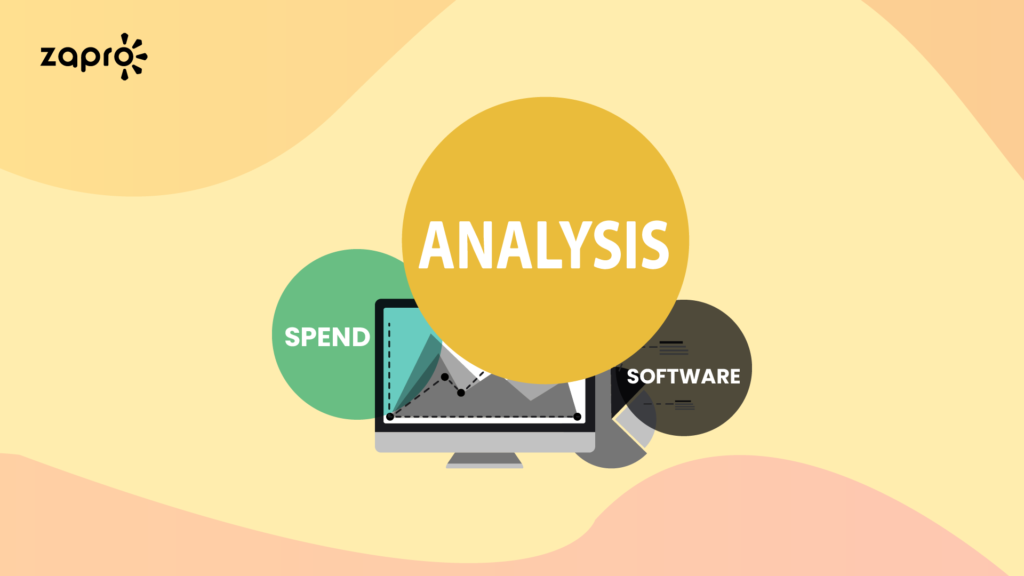In the realm of business, the key to success hinges on effectively managing operational expenses and refining the procurement process. As the business landscape evolves, the expectation from procurement teams extends beyond mere cost reductions. To drive value beyond savings, procurement teams need complete and accurate information about the company’s transactions and the right analytical tools. This is where the concept of “spend analysis” comes into play.
What is Spend Analysis?
Spend analysis is a process that involves gathering, cleaning, classifying, and examining procurement spend data to uncover cost reduction opportunities, enhance efficiency, and promote value beyond savings. Essentially, it offers insights into an organization’s spend structure and helps bring about strategic changes.
In simpler terms, spend analysis is the practice of transforming raw data into valuable information. The insights derived from spend analysis can enhance spend-management visibility, facilitate sustainable cost reduction, and help achieve strategic procurement objectives.
Why is Spend Analysis Important?
The importance of spend analysis cannot be overstated. It brings numerous benefits to an organization, some of which include:
- Full Visibility on Spend: One of the primary benefits of spend analysis is that it provides complete visibility and actionable spend intelligence. It offers a comprehensive view of the metrics that drive improved cost savings, process efficiency, and supply-chain performance.
- Identify Savings Opportunities: Spend analysis helps meet cost reduction goals and also follow up on incremental savings initiatives. Improved visibility helps identify cost-saving opportunities by reducing wasteful and maverick spending.
- Streamline Operations: Spend analysis contributes to cost-effectiveness and process efficiency in many organizations. It reduces the cycle time for creating reports and ad-hoc analyses, thereby reducing labor costs and freeing up time for more productive work.
- Manage Risks: Good spend analysis data will allow you to track and identify suppliers who have non-contracted spend and spend with non-contracted vendors. Enriching spend data with suppliers’ credit scores and other revenue information can better assess your organization’s overall supply chain failure risk.
- Improve Supplier Performance: Once the organization determines which suppliers offer the best value, it can work with them to establish more evolved procurement processes and inventory programs.
What is Spend Analysis Software?
A spend analysis software is a tool that helps businesses collect and categorizes robust spend data from numerous sources, including POs, invoices, and other financial documents. It enables companies to analyze this data to gain insights, streamline their procurement processes, cut costs, and enhance their financial performance. Additionally, spend analysis software also help its users visualize their spending data and create graphical reports that make complex financial information more understandable to technical and non-technical stakeholders.
Spend Analytics vs. Spend Analysis
Spend analysis is often used interchangeably with spend analytics. In reality, they differ in many ways. Spend analysis is the end-to-end collecting, cleaning, classifying, and analyzing procurement data to gain spending insights.
On the other hand, Spend analytics uses data analytics techniques to analyze spending data to spot patterns, trends, and cost-saving opportunities. It focuses more on statistical analysis and machine learning techniques.
The Process of Spend Analysis
A rigorous spend analysis process involves several key steps.
1. Identify Your Objective
The first step in conducting a spend analysis is to identify your objective. The purpose of the analysis will guide the entire process and help you locate relevant data patterns.
2. Identify Data Source
The next step is to identify all possible data sources across your organization. This includes data from accounts payable, general ledgers, ERP systems, and any other internal systems or external sources that contain relevant information.
3. Consolidate Spend Data
Once you have identified your data sources, the next step is to gather this data and consolidate it into one central database. This step may prove challenging as data may be in different formats, languages, and currencies, but it is crucial for a successful spend analysis.
4. Clean and Organize Data
Cleaning and organizing your data is a critical step in the spend analysis process. This involves removing errors and discrepancies in descriptions and transactions to ensure the accuracy of the data.
5. Classified Spend Data
Organize and categorize your consolidated spend data based on predetermined criteria. Classifying expenditures by department, type, or other relevant factors enhances precision in analysis and facilitates strategic decision-making.
6. Link Spend Data to Suppliers
Linking your spend data to the relevant suppliers is an essential step if your spend analysis objective is related to the supply chain. Grouping all purchases made from suppliers belonging to the same parent company will give you a clearer picture of your supply chain.
7. Develop a Category Strategy
Categorizing your spend data using a standardized category system can provide spend-management visibility and help you achieve sustainable cost reduction.
8. Analyze Spend Data
The last step in the process is to analyze your data using your spend analysis tools. Measure your spend data against key performance indicators (KPIs) to understand your performance.
9. Repeat Regularly
Given that your spend data is continuously changing, it is crucial to perform regular spend analysis. Regular analysis can help you uncover new savings opportunities, identify new risks, and continually improve your procurement process.
Key Performance Indicators (KPIs) for Spend Analysis
Key Performance Indicators (KPIs) are measurable values that demonstrate the effectiveness of a company’s business objectives. In spend analysis, KPIs are used to measure the effectiveness and performance of procurement management. Some common KPIs for spend analysis include:
- Process Efficiency Through Requisition-to-Order Time: Requisition-to-order time is the average period between the submission of a requisition and the issuance of a Purchase Order.
- Compliance Through Pre-Approved Spend: Pre-approved spend is the percentage of spend that is approved before an order is made.
- Savings Through Realized Saving: Realized savings is the amount of savings realized through supplier contracts.
- Supply Resiliency via Spend Consolidation: Evaluate the resilience of the supply chain through strategic spend consolidation.
- Risk Management: Assess the effectiveness of strategies in mitigating procurement-related risks.
Top Benefits of Spend Analysis
Conducting a thorough spend analysis can bring numerous benefits to your business. Here are a few key benefits:
- Reduce Maverick Purchasing: Maverick purchasing refers to purchases that do not align with your company’s procurement policy. Spend analysis can help track maverick purchasing and identify savings opportunities by minimizing this type of spending.
- Supply Base Reduction: Spend analysis can help identify opportunities for driving more value from fewer suppliers, leading to a reduction in your supply base.
- Free Your Working Capital: Spend analysis can help optimize your working capital. By identifying suppliers with lower-than-agreed payment terms, you can renegotiate these terms to free up working capital for other business needs.
- Reduce Delivery Delays: Spend analysis can help identify the reasons for delivery delays. If the delay is due to supplier performance, sharing this information with suppliers can significantly improve delivery performance.
- Minimize Supply Chain Disturbances: Spend analysis can help minimize disturbances in the supply chain by identifying single-sourced items and developing a multiple supplier base for these items.
Comparison Of The Best Spend Analysis Software
The 14 Best Spend Analysis Software in 2023
Now that you know the features you must watch when selecting spend analysis software, it’s time to decide. To rid you of the burdensome task of researching the numerous options available out there, we have done the heavy lifting and shortlisted the 14 best spend analysis software that you can consider for your business needs:
Let us dive deeper into each of these tools and explore their features.
1. Zapro
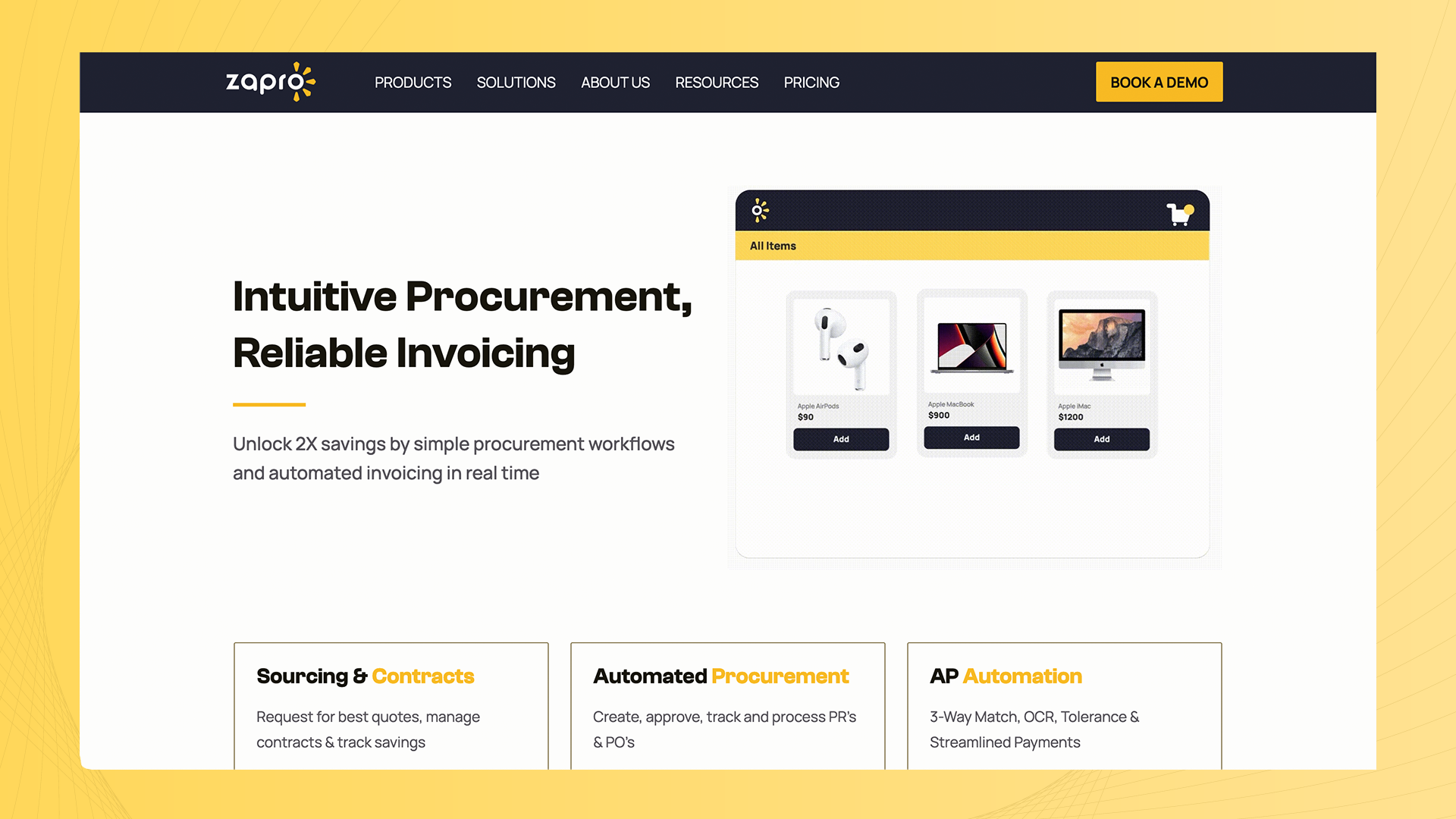
Zapro is a spend analysis software that increases your working capital by reducing unnecessary spending and payables across your business units. It has earned the top spot on the list because it dramatically simplifies the purchase process and automates spend management like no other. Implementing Zapro for your spend analysis will guarantee you deliver strategic cost savings and secure reliable supply sources by leveraging its robust source-to-contract capabilities.
G2 Rating: 4.7 (14 Reviews) Free Trial: Available
Features:
- e-Procurement, Assisted Buying
- Hosted and Punchout Catalogs
- Services Procurement
- AP Automation and Compliances
- Store Management
- Contracts Lifecycle with Compliance Management
- Two Way, Three-way, Multi-Way Matching
- Cloud Deployment
- No Code Customizable Platform
- Slack / Teams Integration
- Reports and Analytics
- Webhooks and API Support
Pros:
- Gain a holistic, data-driven view across your supply chain and supplier base.
- Mitigate third-party risk and establish supplier compliance.
- Drive deeper collaboration with suppliers and vendor management.
- Reduce or eliminate eSourcing process workflow inefficiencies.
- Establish a seamless, high level of collaboration between stakeholders internal and external.
- Significantly reduce cycle times to accelerate business opportunities.
- Better manage spend to cut costs and increase savings across categories.
- Create contracts faster and more easily directly from sourcing events.
2. SAP Ariba
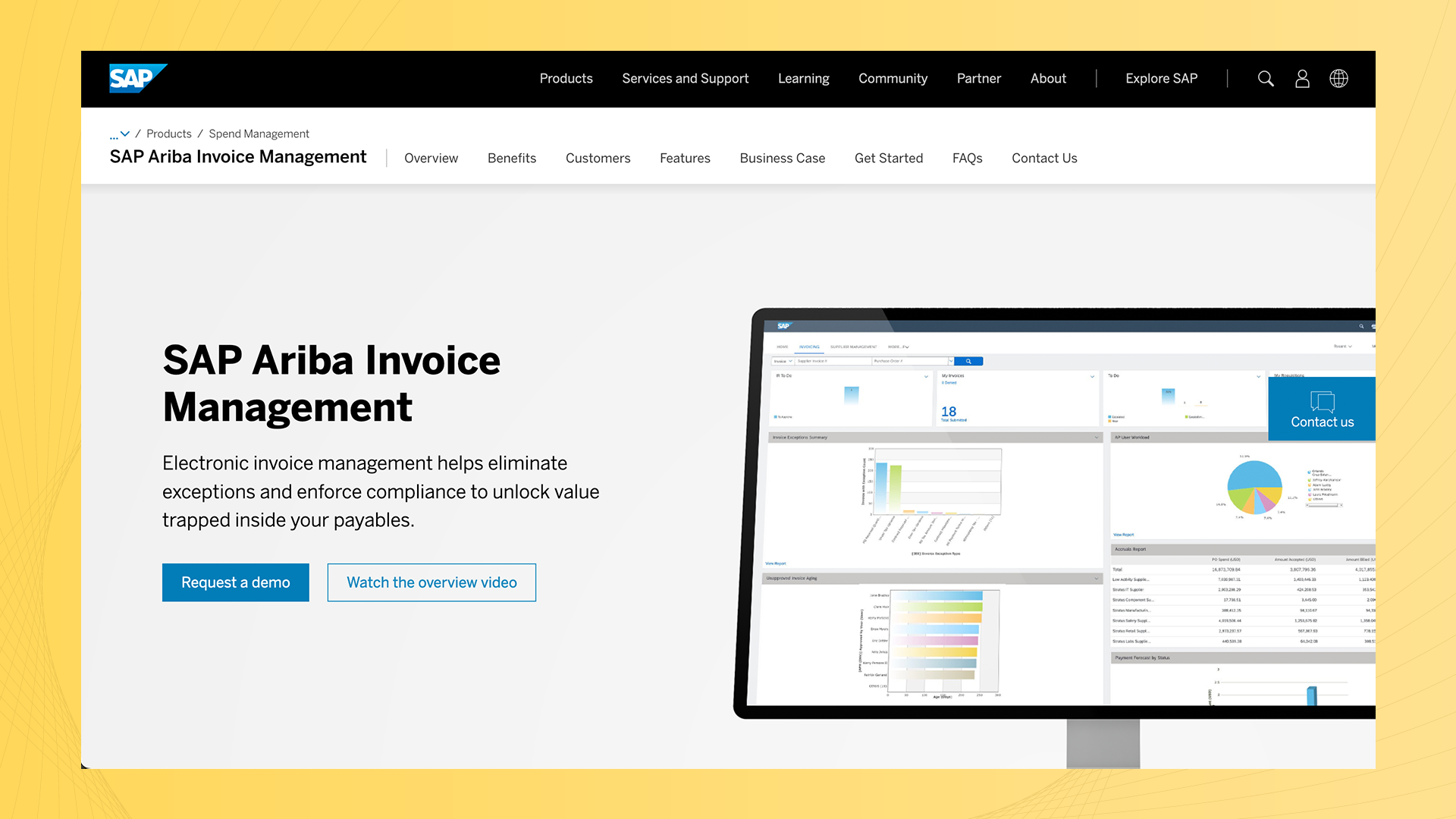
SAP Ariba is a cloud-based spend analysis software that helps businesses gain visibility into their spending habits and make data-driven decisions to reduce costs and improve efficiency. It offers a suite of e-procurement tools and analytics solutions that help streamline procurement processes, manage suppliers, and optimize spending.
Features:
- Automated data analysis to identify spending patterns and trends
- Customizable reports and dashboards for better spend analysis
- Supplier management tools for managing supplier relationships and optimizing procurement
- Direct B2B contacts and vendor base buildup
Pros:
- Customizable reports and dashboards allow businesses to track spending in real time.
- Supplier management tools improve procurement team efficiency.
Cons:
- SAP Ariba is a complex solution that requires significant setup and configuration, which can be time-consuming and challenging for small business units.
- The software can be expensive, which may not be feasible for small businesses with limited budgets.
- Some users have reported difficulty with the user interface and finding certain features.
3. Zycus
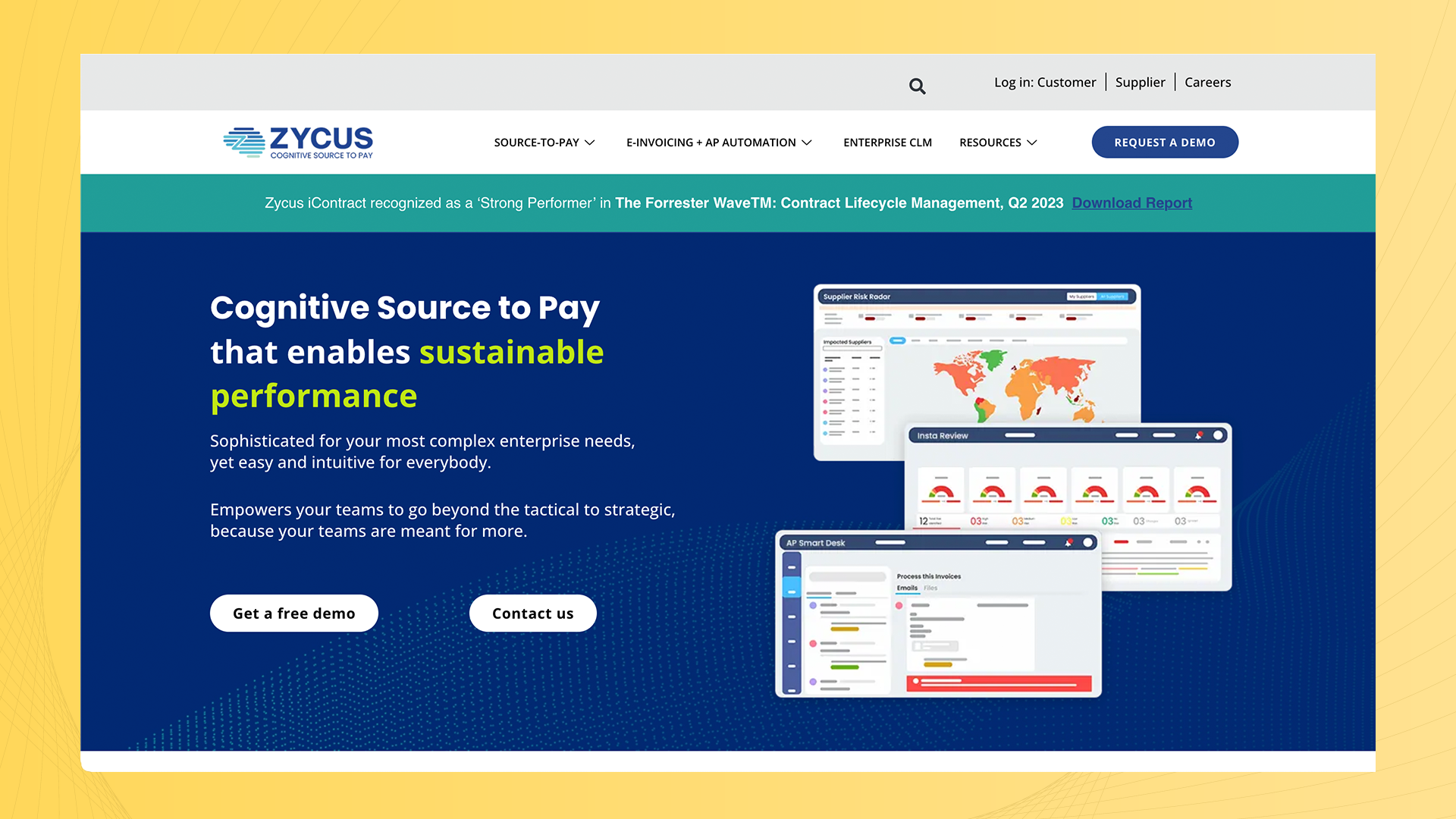
Zycus is a procurement software suite that offers a range of modules to help organizations streamline their procurement processes and reduce costs. Its flagship product, the Zycus Procure-to-Pay (P2P) solution, is designed to automate and simplify the procurement process from requisition to payment.
Features:
- Automates the procurement process from requisition to payment
- Manage contracts more efficiently by reducing the risk of non-compliance.
- Granular, consistent & timely data classification with AI technology.
- Multilingual data recognition.
- Intuitive & actionable dynamic dashboards with real-time data refresh.
Pros:
- Sufficient storage
- Ideal software for auditing
- Zycus Supplier Management helps organizations manage supplier relationships more effectively, reducing risk and improving supplier performance.
Cons:
- Inadequate technical advancements
- Poor customer service
- Some of the software’s more advanced features may require effective training and expertise.
4. GEP Smart
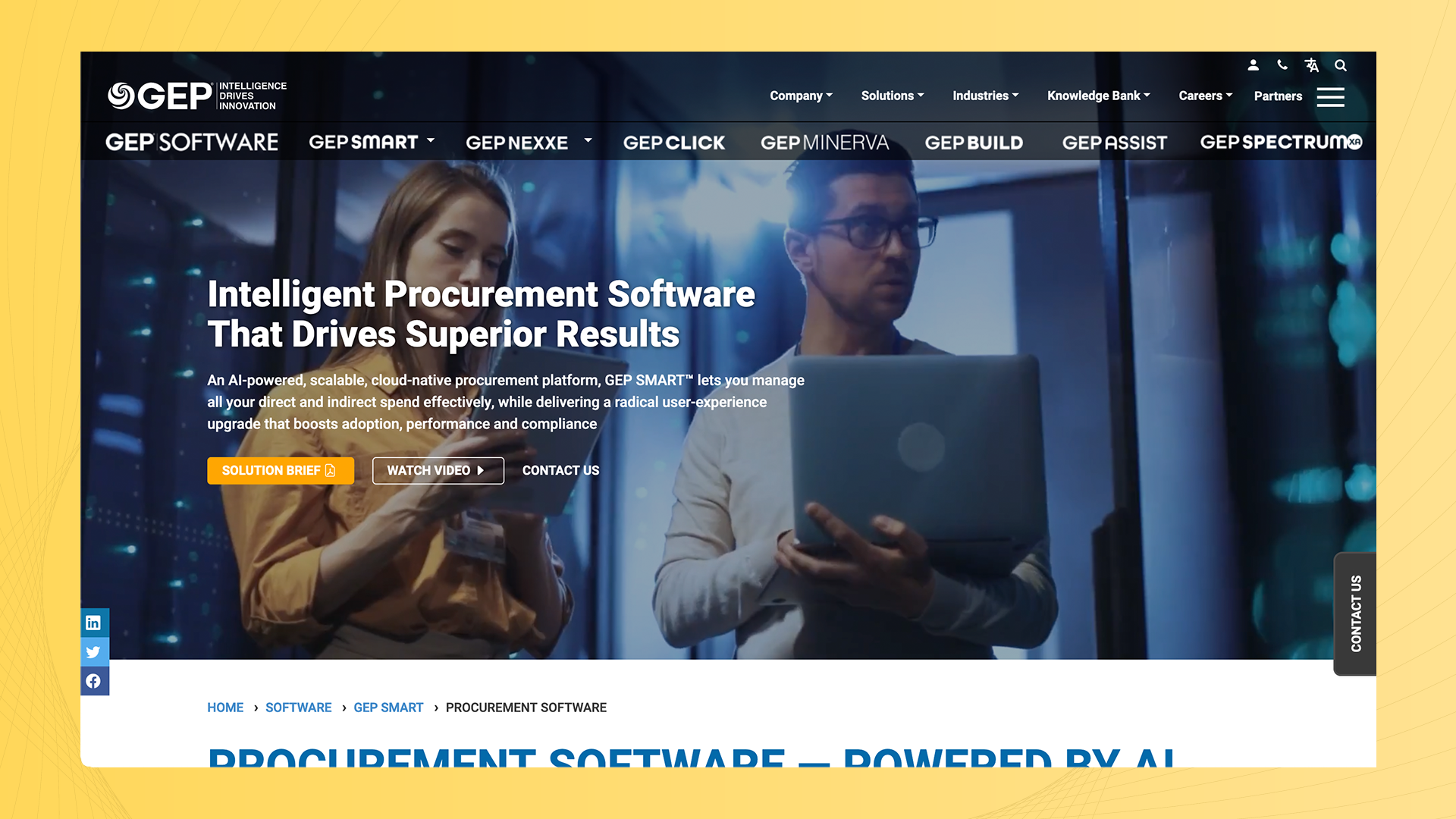
GEP Smart is an intelligent unified procurement software built to streamline direct and indirect procurement spending. The platform’s spend analysis technology comprehensively examines your business spend to promote reduced compliance issues, spending efficiency, costs, and wasteful purchases.
G2 Rating: 4.4 (23 reviews)Pricing: Available on request
Features:
- Supplier management and category management
- Integration with SAP ERP, Oracle ERP, JD Edwards
- Customizable reporting and dashboards
- Procure-to-pay capabilities
Pros:
- Scalable
- Provides an informative supplier performance analysis
- Advanced analytics capabilities for procurement optimization
Cons:
- Limited pricing plans
5. Happay
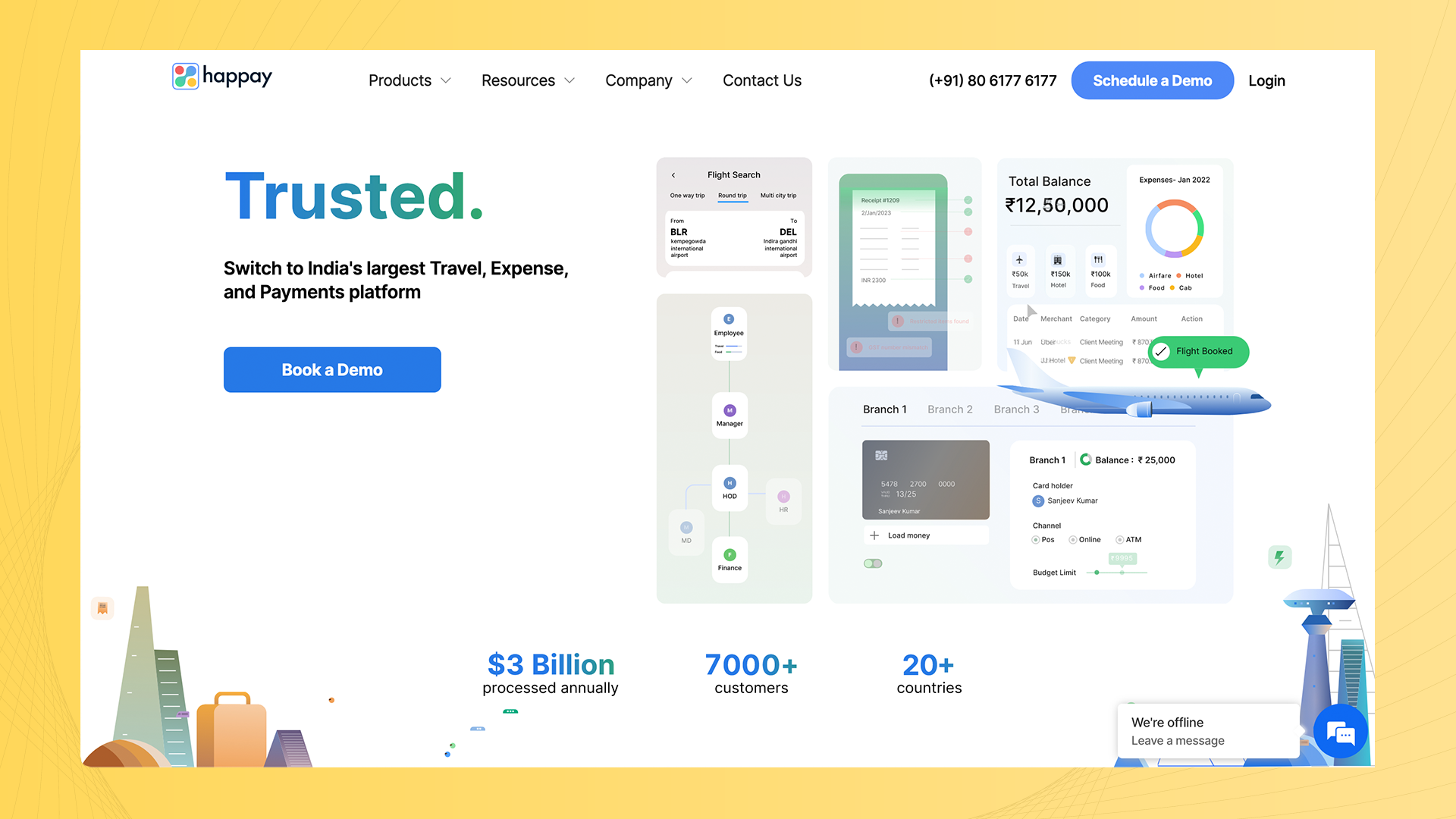
Happay is a T&E platform that leverages spend analysis technology to acquire accurate and elaborate information on spending, compliance, efficiency, and policy violations. Its spend analysis feature allows users to analyze, control, and optimize their costs to prevent overspending and improve decision-making.
G2 Rating: 4.5 (292 reviews)Free Trial: Not Available
Features:
- Customizable expense policies
- Integrates with Tally, QuickBooks
Pros:
- Smart audit features
- Efficient expense management and reporting
- Convenient for auditing
Cons:
- Subscriptions are limited
6. Precoro
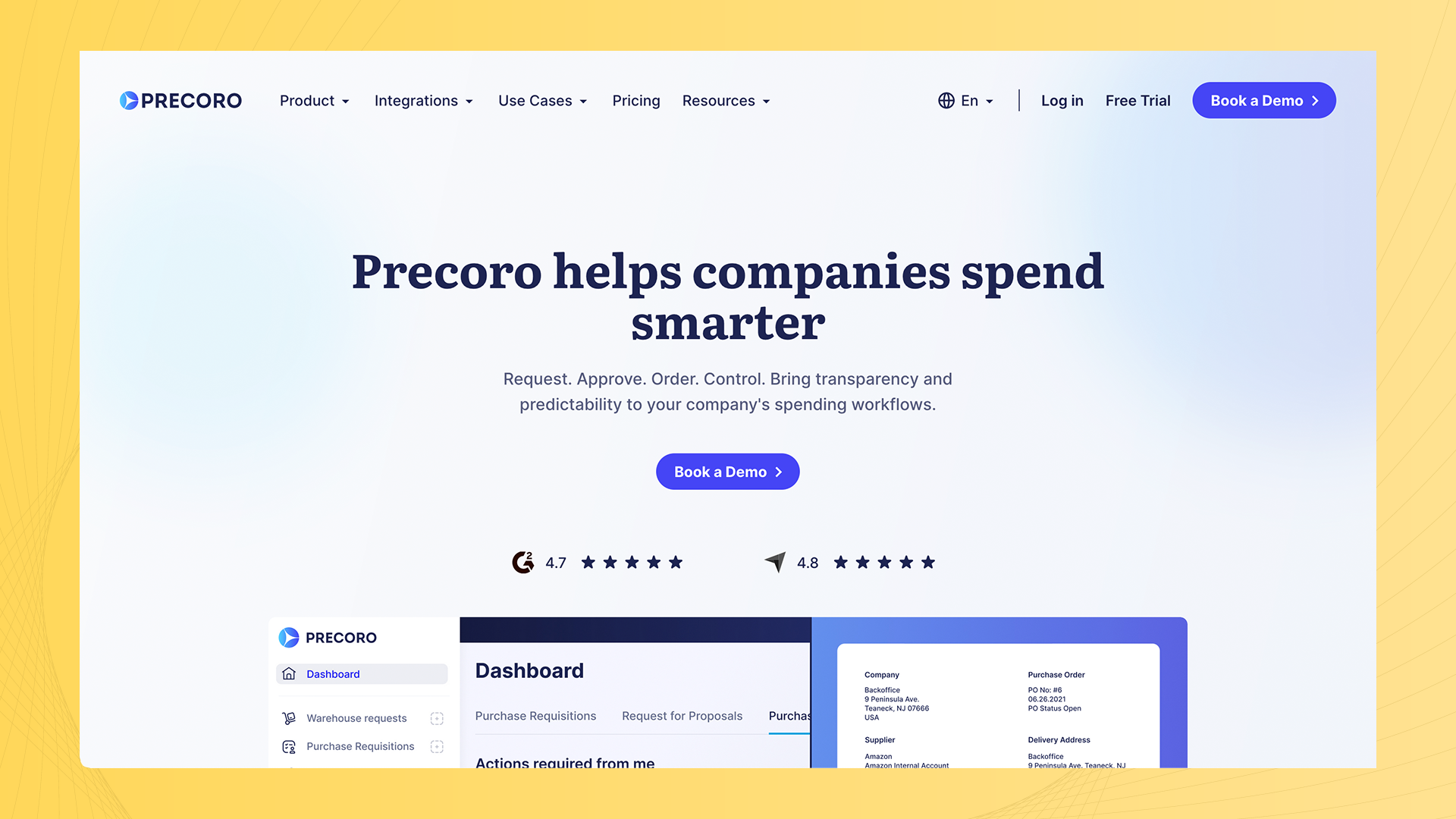
Precoro is an innovative cloud-based software for small and mid-sized businesses for optimizing procurement processes. Precoro helps eliminate manual, error-prone procedures, improves visibility, coordinates purchase processes, and reduces expenses.
G2 Rating: 4.7 (114 Reviews)Pricing: Starting from $35.00/month Free Trial: Available
Features:
- Streamline the approval workflow by adding as many steps as you need.
- Automated operations and centralized purchasing processes only.
- Access data from anywhere with real-time tracking.
- Create, approve, and track POs or transfer orders from Amazon Business via Punch-in.
- Manage suppliers, item catalogs, inventory, and more within one platform.
Pros:
- It integrates with Slack, Zero, NetSuite, QuickBooks, and Amazon Business Punch-in.
- It creates paperless approval by electronic purchase orders efficiently.
- It reduces staff time in the procurement process.
Cons:
- The inventory module lacks functionality.
- Lack of deep dive into visual analytics
- Editing POs is a complicated process
7. Sievo
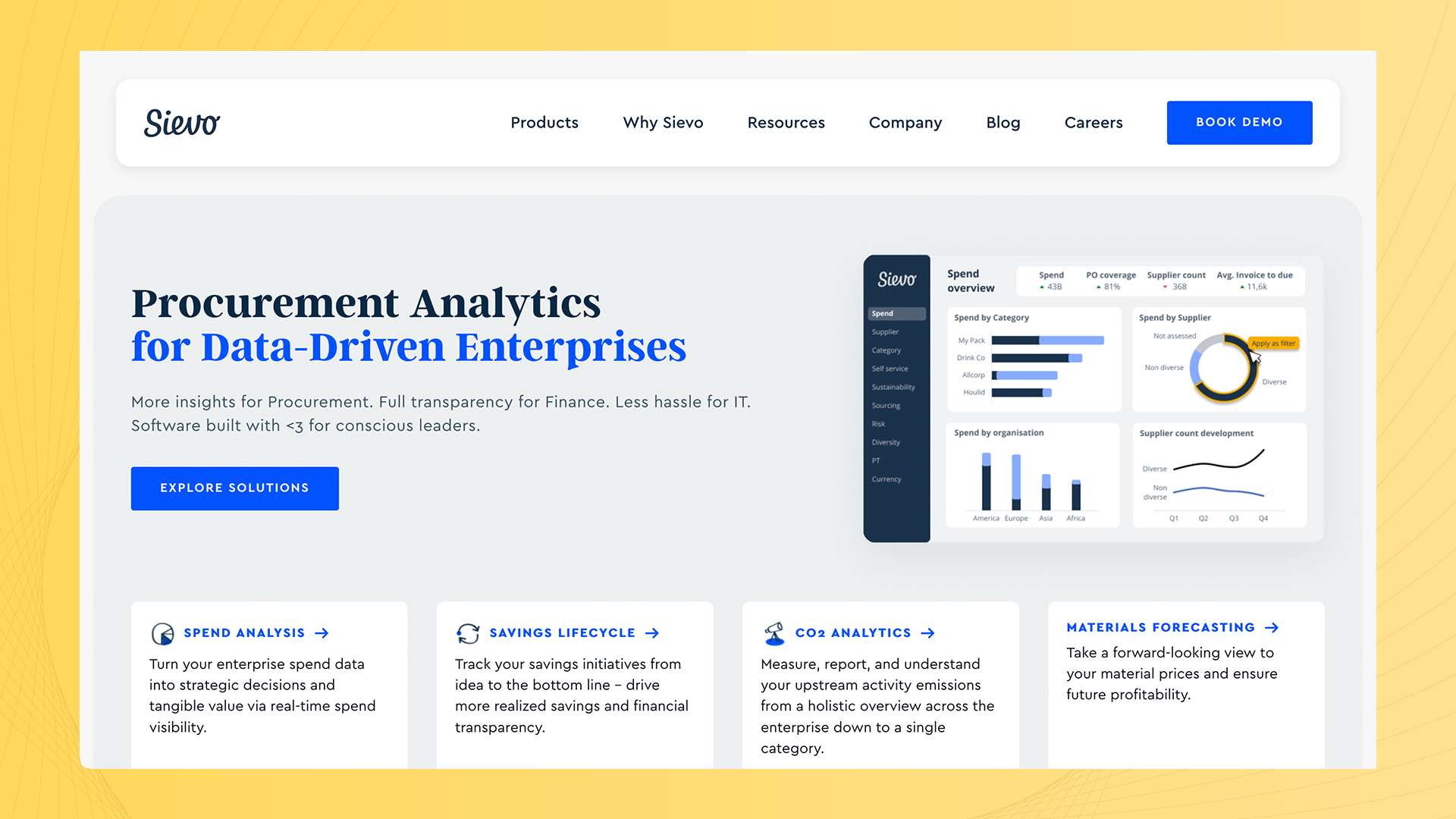
Sievo Spend Analysis is a fully featured eProcurement software combining procurement expertise and machine learning for faster and more reliable spend visibility. It is designed to serve SMEs and startups and provides end-to-end solutions designed for Web App.
G2 Rating: 3.5 (3 Reviews)Â Pricing: Prices available on requestFree Trial: Available
Features:
- It categorizes the spend data, reducing the need for manual categorization with the help of advanced algorithms.
- It offers advanced data visualization tools that identify spending patterns and trends quickly.
- It allows businesses to measure actual and projected spend in real time across different departments.
Pros:
- It boosts the value of the contract lifecycle by merging spend data and contract management solutions.
- It allows businesses to design detailed budgets and forecasts based on transaction-level purchasing data incorporated from multiple sources.
Cons:
- It is a high-end software
- Meant for enterprise-level organizations only
8. ProcurePort
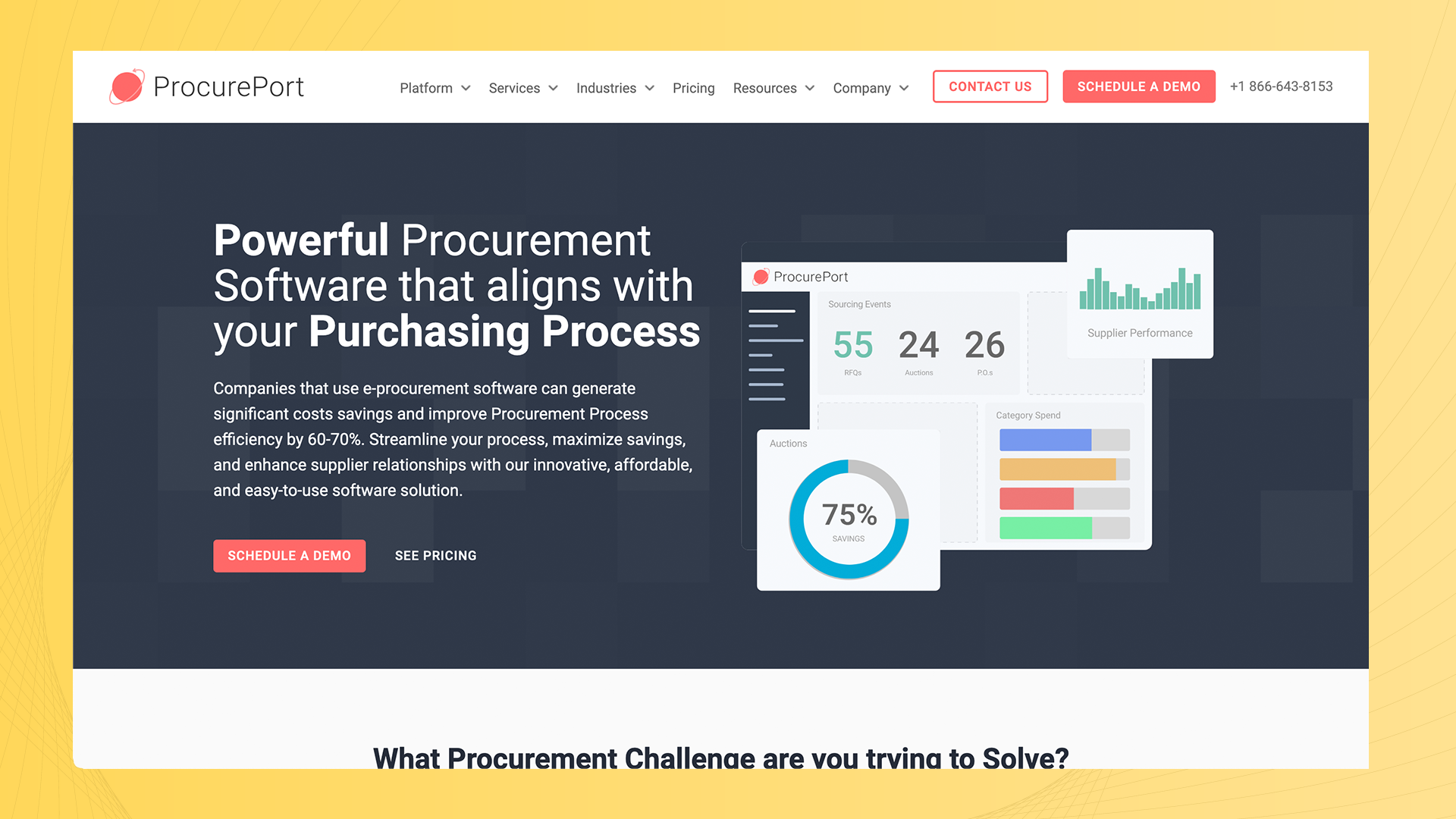
ProcurePort is a cloud-based procurement software that provides end-to-end solutions for Web-App designed to serve agencies and enterprises. It helps businesses automate their procurement processes, improve spending management and manage supplier relationships.
G2 Rating: 4 (13 Reviews)Â Pricing: Pricing available on request Free Trial: Available
Features:
- It automates the entire source-to-pay procurement process.
- It helps identify areas of potential savings and optimize procurement strategies through advanced analytics.
- It effortlessly integrates with third-party ERPs and requires minimal configuration.
Pros:
- It helps users create custom workflows and approval processes and can be customized to specific business needs.
- Its user interface is intuitive and user-friendly.
- It offers affordable pricing plans suitable to businesses of all sizes.
Cons:
- Its reporting system lacks advancement.
9. Ivalua
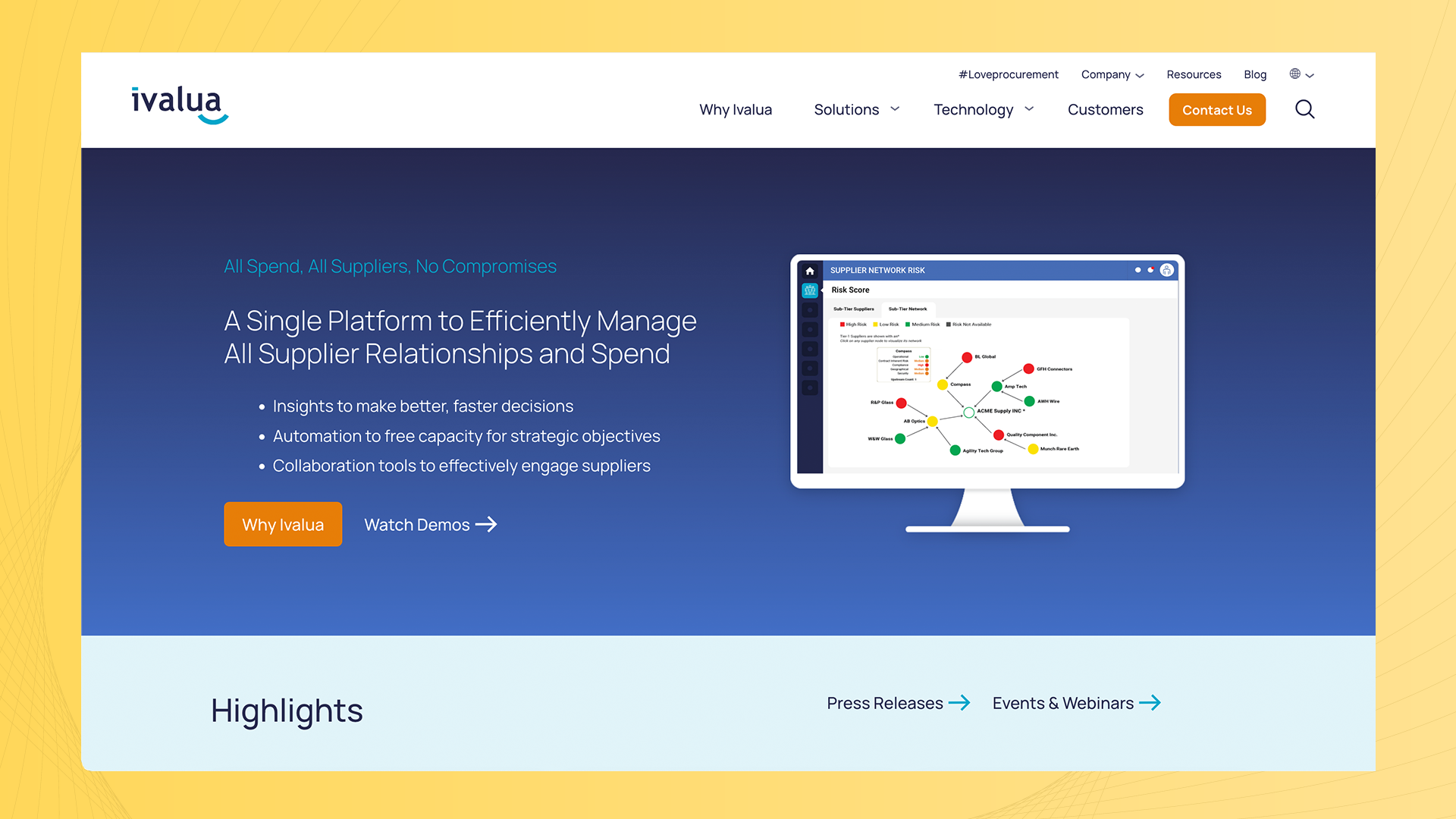
Ivalua is a procurement empowerment platform that helps businesses implement Source to Pay processes for all categories. It is designed for agility, performance, and scale. It is an industry-leading cloud environment that allows you to scale up or down with the highest security and performance standards, regardless of place or device.
G2 Rating: 4 (17 Reviews)Â Pricing: On Request Free Trial: Available
Features:
- Fully digitalized procurement and supply chain processes
- Manages all spending categories
- Improves transparency and data quality
Pros:
- Easy configuration and easy to use
- Meet your users’ needs, from custom UI and workflows to new forms and fields
- It collaborates with suppliers and other stakeholders by customizing processes to their needs
Cons:
- Fewer templates for e-Auction
- It doesn’t integrate easily with the existing platform and warehouse ERP for end-to-end automation
- Customer support could respond a bit quicker
10. Coupa
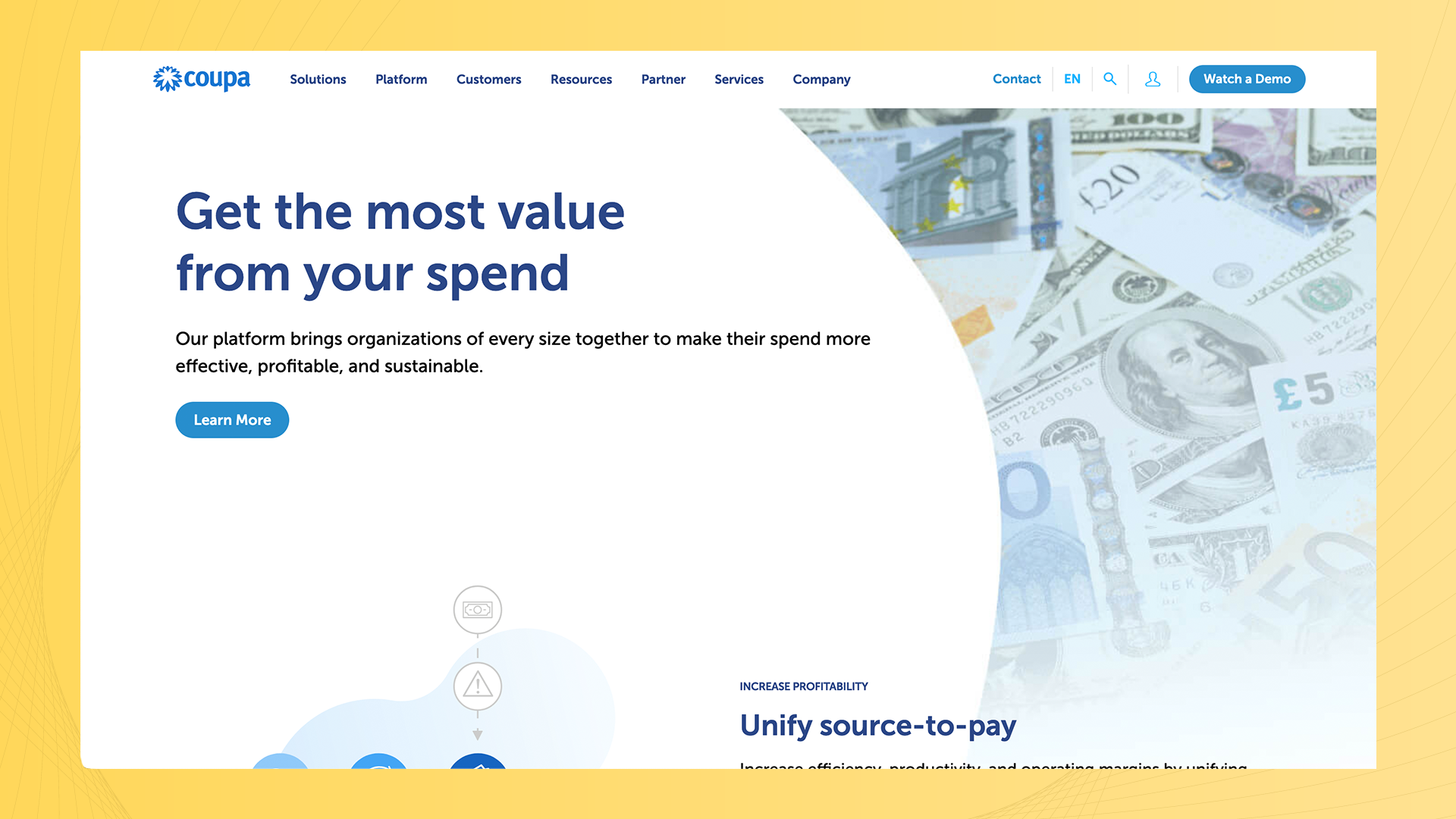
Coupa is a dynamic and intuitive cloud-based procurement software designed to help businesses manage their procurement processes, automate workflows, and improve spend management. The software is a time-saving and profitable solution, offering various features to streamline procurement workflows and improve supplier relationships.
G2 Rating: 4.2 (238 Reviews)Â Pricing: Pricing available on request Free Trial: Available
Features:
- It helps conduct events, with a feature to add project briefs to the sourcing events
- Its procure-to-pay features help businesses streamline procurement processes and reduce costs
- Its advanced expense management feature includes travel and expense management, invoicing, and payment processing
Pros:
- It is a one-stop shop for procurement needs as it offers a comprehensive set of procurement features
- It helps reduce risk and improve supplier performance
- It facilitates quicker approval processes that boost strong customer relationships
Cons:
- It does not support complete accounting
- It lacks a project accounting suite which may be challenging for project-driven organizations
11. Kissflow Procurement Cloud
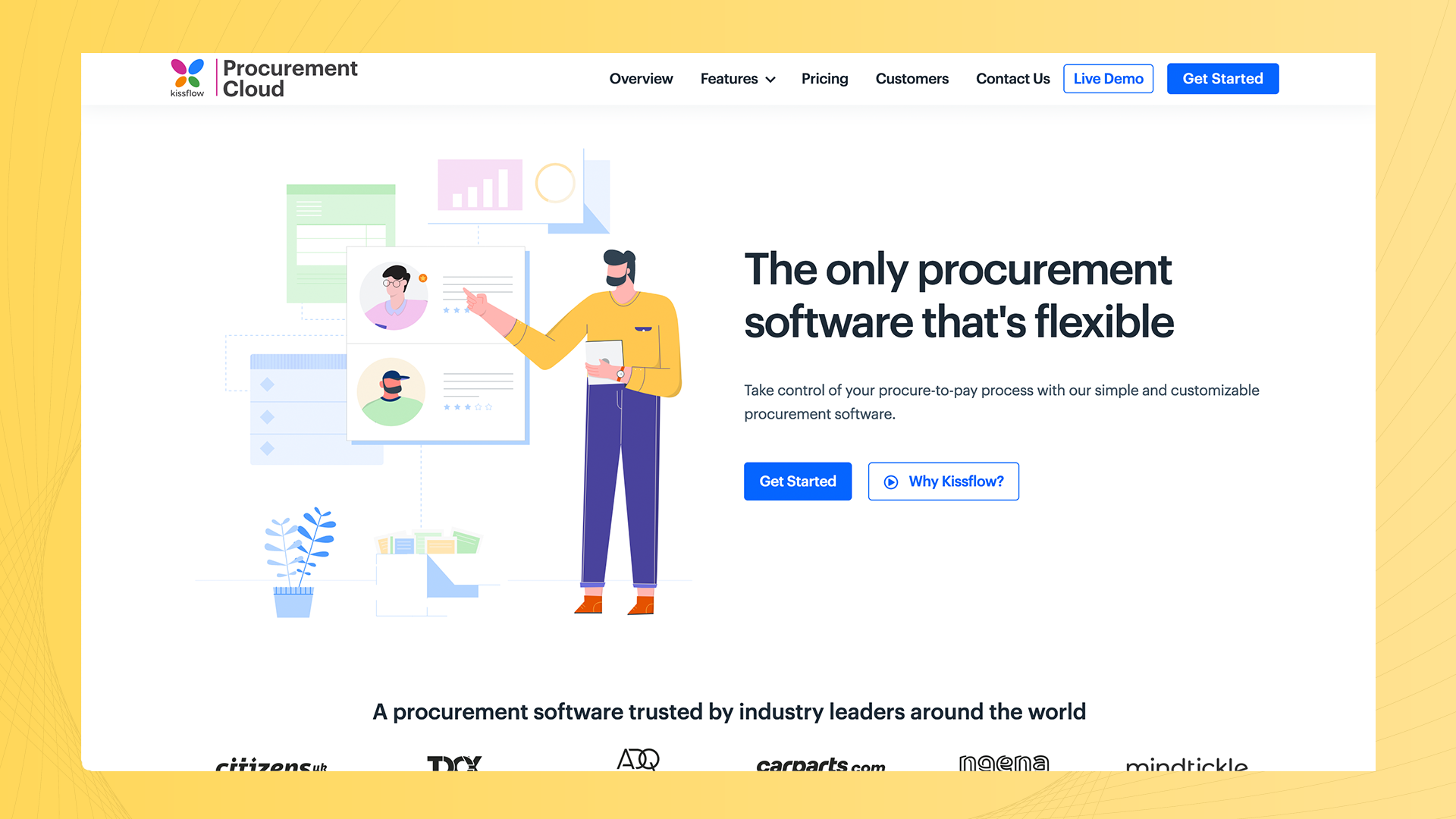
Kissflow Procurement Cloud is a flexible procure-to-pay software that allows businesses of all sizes to streamline their procurement processes. The software solution offers everything from purchasing to vendor management in one platform. It also includes Purchase Orders, Purchase requisitions, Vendor Management, Purchase Invoicing, Analytics, and Integrations.
G2 Rating: 4.8 (2 Reviews)Â Pricing: Pricing available on request Free Trial: Available
Features:
- Quick implementation with the least disruption for businesses automating their procurement processes
- Tools to manage procurement needs for goods and services and address compliance requirements
- Self-service portals for suppliers to update personal data and receive notifications of new orders or pending payments
Pros:
- It has a flexible and modular solution approach
- It helps monitor product levels, place purchase requests, and track real-time status through automated updates
Cons:
- Master list updating is not automated
- Some features are a bit too rigid
12. Corcentric
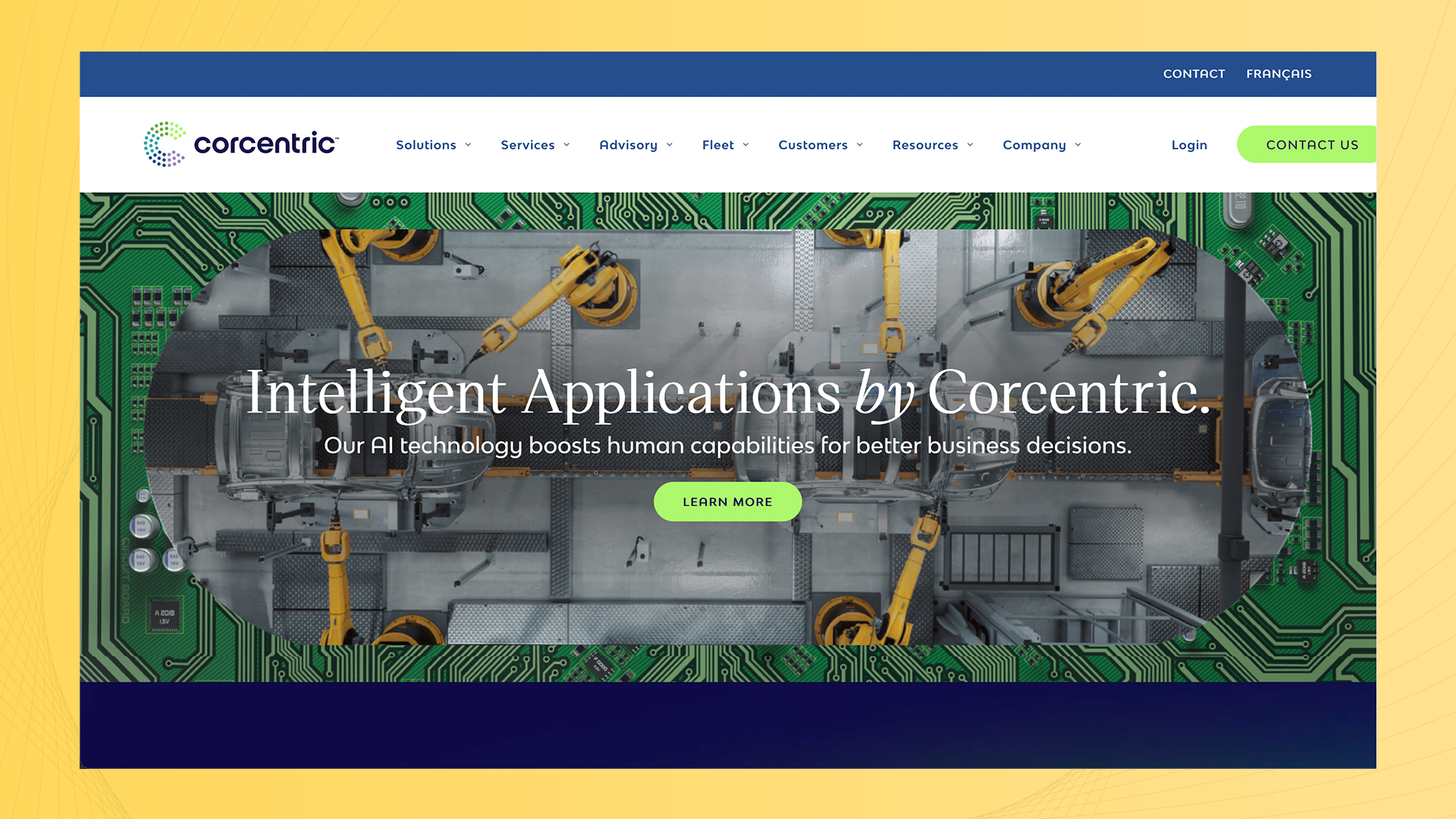
Corcentric is an end-to-end global procurement provider of accounts payable and accounts receivable solutions. It offers full Source-to-Pay and Order-to-Cash solutions that focus on reducing costs, improving working capital, and unlocking revenue to transform how companies buy, pay, and get paid.
G2 Rating: 3 (5 Reviews)Â Pricing: On Request Free Trial: Available
Features:
- It includes Analytics, Sourcing, Supplier Management, Contract Lifecycle Management, Procurement, Invoice Management, Financial Management, and Payment solutions.
- Integrates data and workflows across purchasing, suppliers, finance, and contracts.
- Streamlines processes to save money, improve efficiency, reduce risk, and increase working capital to drive measurable results.
Pros:
- It provides a complete view of spend, suppliers, and contracts to help businesses maximize procurement performance.
- It enables frictionless purchasing, compliant spending, and streamlined payments.
- It improves working capital and cash flow with guaranteed payments, eliminates credit risk, and reduces DSO.
Cons:
- Functionality could be more flexible.
- The user interface is not intuitive.
13. JAGGAER
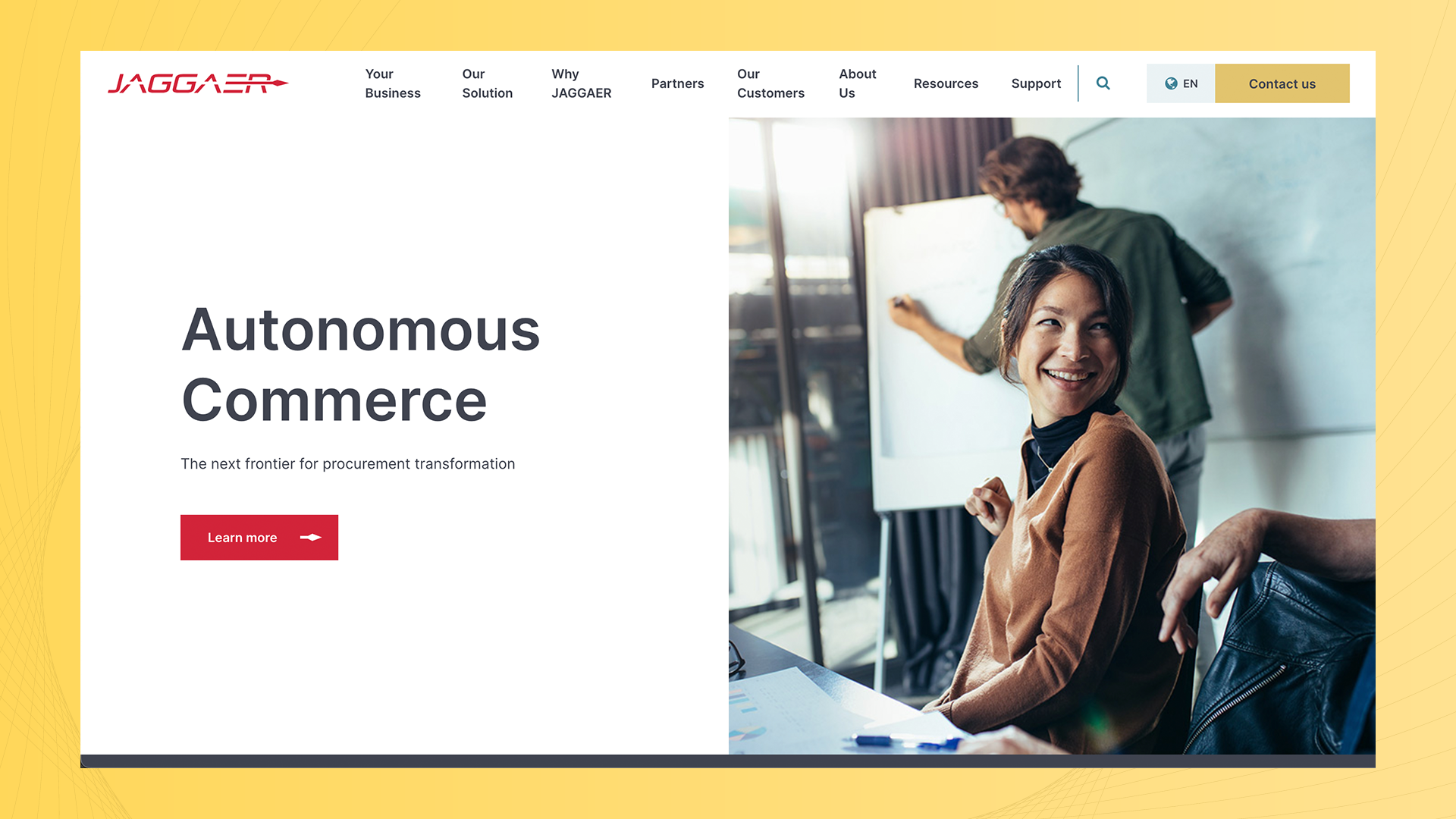
JAGGAER Spend Analytics is a platform designed to Identify savings opportunities and grow revenue that provides actionable insights across all spends. It specializes in uncovering areas for optimization, reducing unit prices, minimizing non-compliant spending, consolidating suppliers, and creating business unit collaboration.
G2 Rating: 4.4 (27 reviews)Pricing: Prices are available on request, and a free demo is available
Features:
- Contract management, spend analysis
- Supplier performance evaluation
- Customizable procurement workflows
Pros:
- Integration with SAP, Oracle, Coupa
- Procurement Analytics
- Efficient contract management
Cons:
- Custom pricing
14. Spend HQ
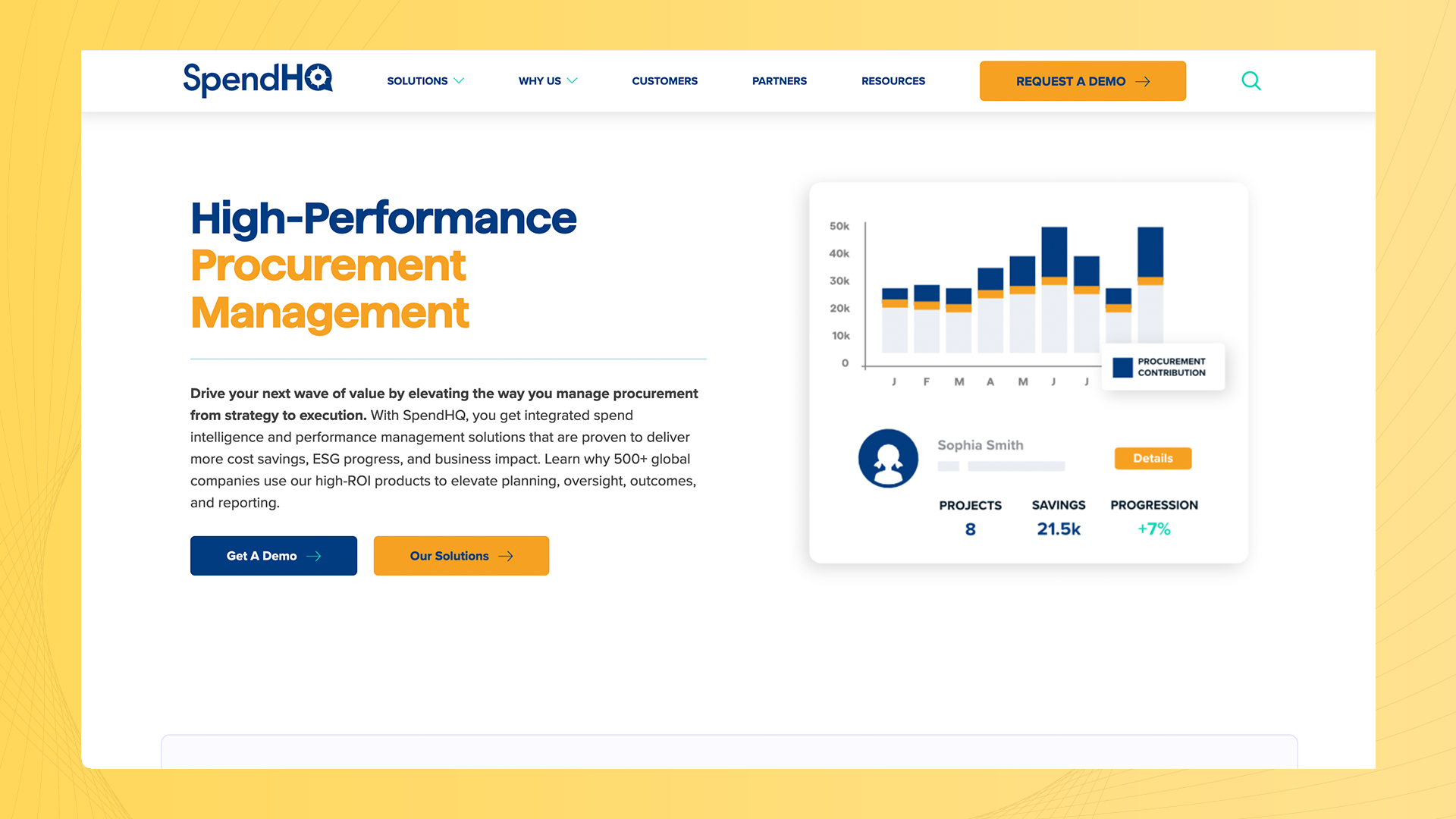
SpendHQ primarily focuses on solving spend visibility challenges for its customers. It is an easy-to-use spend analysis SaaS application that provides your internal partners and users with a clear overview of business spending. It is a good platform able to identify untapped savings opportunities, view benchmarks, and create custom reports.
G2 Rating: 4.6 (27 reviews)Pricing: Prices are available on request with the option of a free demo
Features:
- Supplier management, custom reporting
- Integrates with QuickBooks, NetSuite
Pros:
- Simplified supplier performance evaluation
- Customizable reporting and dashboards
- User-friendly interface
Cons:
- Deployment typically takes up to 3 months.
What to keep in mind when choosing the best spend analysis softw are
As promised, let’s take a look at the critical factors you must look into when selecting a spend analysis software before investing in a solution:
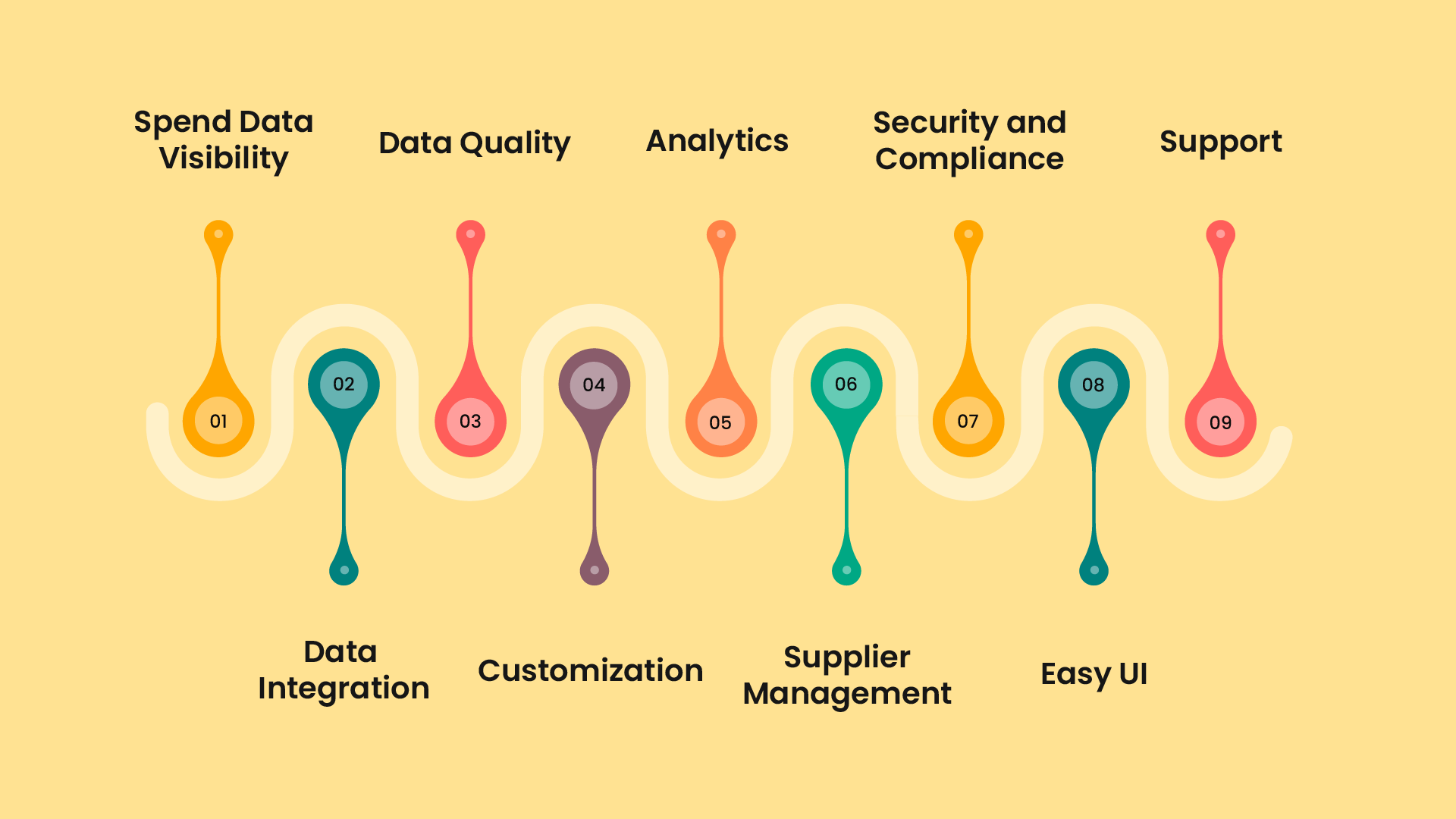
1. Spend Data Visibility
“Data visibility is essential to building a spend management strategy. It’s not, for example, knowing how many pens we purchased. The question becomes what are we doing with that insight to save money on office supplies.” – Joe Payne, Senior VP of Source-to-Pay at Corcentric.
Your company’s spending data is critical to the spending analysis puzzle. The more clarity you have on your spending patterns, the easier it will be to build a spend management strategy. So ensure you invest in a spend analysis software that gives you clarity on your company’s spending patterns.
2. Data Integration
The tool should be able to integrate with various data sources, such as ERPs accounting systems and supplier portals, to collect all the relevant spending data. Remember, by engaging in spend analysis software that smoothly integrates with your existing systems; you streamline your data transfer and accuracy.
3. Data Quality
The accuracy of your data classification is an essential factor affecting your spend analysis’s reliability. Hence your chosen tool must reflect this necessity and have robust data cleansing and classification capabilities. With such software, the accuracy and consistency of data will never be a problem again.
4. Customization
Every business has its unique processes, requirements, and goals. A good tool should be customizable and flexible enough to meet your organization’s and industry’s needs. So look for customizable software matching your terminologies, workflows, and other requirements.
Remember, your investment should allow you to tailor the spend software to bend to your company’s growing needs dynamically. In other words, it should have custom user permissions, roles, reporting, and dashboards.
Even the best customizations are only worthwhile if the software is scalable, takes time to deploy, and is too expensive. So pick a solution that can scale along with your growth, can be quickly deployed, and is cost-effective.
5. Analytics
Data visualization and reporting are two of the most critical capabilities any spend analysis software should have. The tool must provide easy-to-use data visualization and reporting capabilities, simplifying how you find key spend patterns and trends. Most importantly, it should give you all the information you need to make strategic data-driven decisions.
6. Supplier Management
Building strong relationships with vendors and suppliers is one of the most critical drivers of controlled spending. A capable spend analysis tool should allow you to achieve this. Let me explain. When your spend analysis software has supplier management capabilities that will enable you to track supplier performance and identify potential risks, it keeps you well informed of current market rates and allows you to negotiate better terms.
7. Security and Compliance
The tool should have robust security measures to ensure the confidentiality and privacy of your data. It should also comply with relevant regulations and standards, such as GDPR and SOC 2. Engaging in such software can safeguard your sensitive financial information from suffering a potentially damaging breach.
8. Easy UI
Even the best tool will only yield the intended results if its users embrace it. This also applies to the software you choose as your spend analysis software. For the tool to succeed, ensure it has a user-friendly interface that is easy to navigate and use for both technical and non-technical users. The most successful tools can be instantly deployed and used without extensive training.
9. Support
However user-friendly the software is, there may come a time when you may need help troubleshooting an issue or require additional information on some of its features. When that time arrives, your spend analysis software provider should be ready to offer adequate customer support and training to ensure users can effectively utilize the tool and maximize its benefits. So find a provider that offers highly responsive customer support and is ready to walk you through any challenge or requirement you face.
Wrapping it Up
Improving spend analysis puts companies in the position to identify trends in time to take a proactive, rather than a reactive, approach that positions the company for the future.
Leaders who focus on spend analysis are well-positioned to meet the challenges of a modern business environment head-on. Finance leaders who fail to take spend management to the next level risk losing out on cost savings and efficiencies. There is also a real danger of falling behind by being unaware of the importance of spend analysis and not considering the consequences of ignoring this vital tool.
Discover Accelerated, Accurate Spend Analytics With Zapro
Zapro’s eProcurement solution is the best way to get value out of your spend. Our Procurement spend analysis platform will instantly enable you to drive powerful insights to cut costs and increase throughput across categories. If you’re still on the fence about the ideal software, why not try ours before you buy? Schedule a demo with us today to transform how you manage your business spend.
